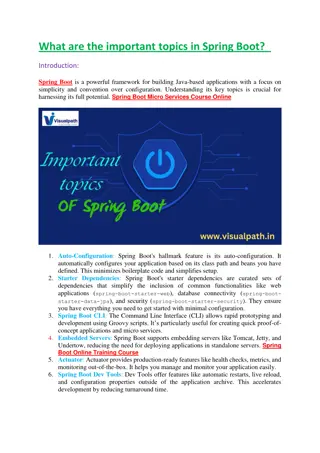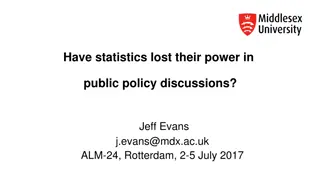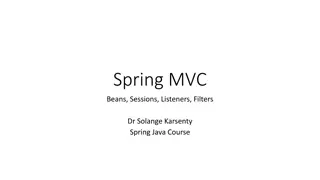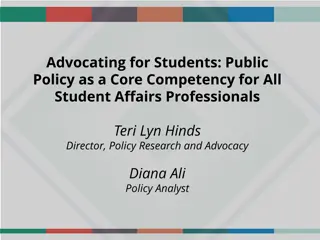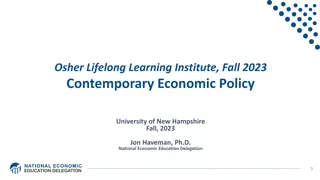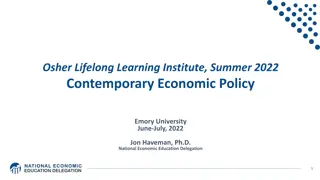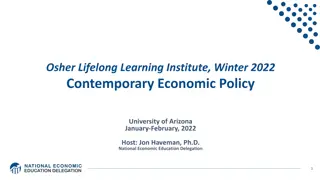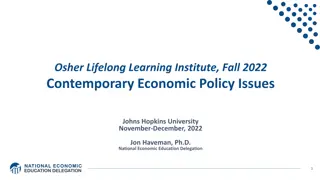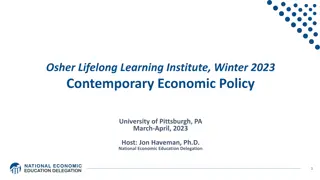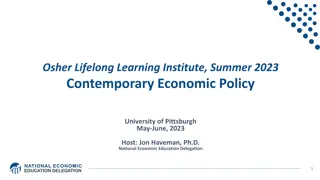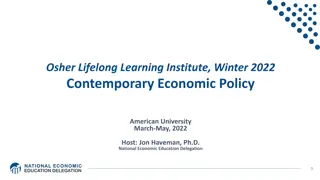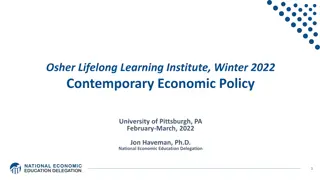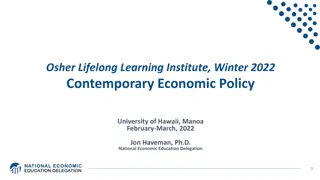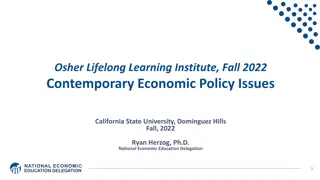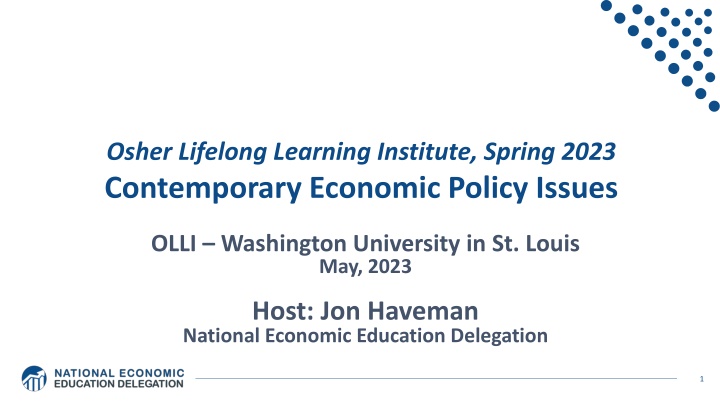
Contemporary Economic Policy Issues at OLLI: Spring 2023
Diverse topics like US economy, healthcare economics, climate change, and more at the Osher Lifelong Learning Institute. Join experts for insightful discussions on economic policy in a nonpartisan setting.
Download Presentation

Please find below an Image/Link to download the presentation.
The content on the website is provided AS IS for your information and personal use only. It may not be sold, licensed, or shared on other websites without obtaining consent from the author. If you encounter any issues during the download, it is possible that the publisher has removed the file from their server.
You are allowed to download the files provided on this website for personal or commercial use, subject to the condition that they are used lawfully. All files are the property of their respective owners.
The content on the website is provided AS IS for your information and personal use only. It may not be sold, licensed, or shared on other websites without obtaining consent from the author.
E N D
Presentation Transcript
Osher Lifelong Learning Institute, Spring 2023 Contemporary Economic Policy Issues OLLI Washington University in St. Louis May, 2023 Host: Jon Haveman National Economic Education Delegation 1
Available NEED Topics Include: US Economy Immigration Economics Healthcare Economics Housing Policy Climate Change Federal Budgets Economic Inequality Federal Debt Economic Mobility Black-White Wealth Gap Trade and Globalization Autonomous Vehicles Minimum Wages Healthcare Economics 2
Course Outline Contemporary Economic Policy - Week 1 (5/5): US Economic Update (Geoffrey Woglom, Amherst College) - Week 2 (5/12): Economic Inequality (Adina Ardelean, Santa Clara Univ.) - Week 3 (5/19): Economic Mobility (Kathryn Wilson, Kent State Univ.) - Week 4 (5/26): The Black-White Wealth Gap (Jon Haveman, NEED) 3
Submitting Questions Please submit questions of clarification in the chat. - I will try to handle them as they come up. We will do a verbal Q&A once the material has been presented. Slides will be available from the NEED website after the talk. (https://NEEDEcon.org/delivered_presentations.php) 4
The Black-White Wealth Gap May 26, 2023 Jon Haveman, Ph.D. National Economic Education Delegation 5
Credits and Disclaimer This slide deck was authored by: - Darrick Hamilton, Ph.D., The New School - Jon Haveman, Ph.D., NEED This slide deck was reviewed by: - Patrick Mason, Florida State University - Steven Craig, University of Houston Disclaimer - NEED presentations are designed to be nonpartisan. - It is, however, inevitable that the presenter will be asked for and will provide their own views. - Such views are those of the presenter and not necessarily those of the National Economic Education Delegation (NEED). 6
Outline Evidence of disparities Why wealth is important Sources of disparities Implications of disparities Policy solutions 7
What is Wealth? Income vs Wealth - Income is the flow of funds into a households each year. - Wealth is a household s NET asset holdings. o The value of all assets minus the value of all debts. o Assets can be financial and physical. Assets include: - Owned homes, cars, stocks, businesses, savings and checking accounts, pensions, life insurance Debts include: - Home mortgages, car loans, credit cards, and any other significant financial obligations (excl regular bills) 8
Total Family Wealth, by Wealth Group Notes: 1) Tremendous growth in wealth between 1989 and 2019. 2) It all went to the top half of the wealth distribution and most of it went to the very top. 10 Source: CBO, Trends in the Distribution of Family Wealth, 1989 to 2019
Wealth is More and More Concentrated 99th Percentile 2016 = 7x 1963 11 Source: Urban Institute
Evidence of the Gap Mean is 7x Greater Median is 8x Greater 13
Widespread Household Wealth Pays Dividends To individuals in the household - Choices/Life Agency - Wealth is iterative And to broader society - Human capital development - Entrepreneurship and innovation 17
Household Level Benefits Choices/Life Agency - Finance high quality education - Living in good neighborhoods - Saving for retirement - Capital to start a business - Withstand financial hardship - Better legal counsel - Exert political influence - Finance costly medical procedure - Bequests Wealth is iterative - Wealth begets more wealth. o Access to higher return investments. - Wealth transfers across generations. o Wealth is sticky. 18
Parental Wealth is Important Important pre-estate transfer effects on kids: - Influences human capital accumulation. - Influences the returns to education. - Adult incomes of offspring. There are clearly enormous differences in wealth held by parents of Black and White children. And it s clear that nurture plays a big role. 19
Tangible Benefits for the Broader Economy More human capital development Increased entrepreneurship Healthier labor force Less social unrest Less reliance on social programs Smaller stock of student loans 21
Events/Policies with Direct Wealth Implications Slave trade - The first deprivation Slavery 40 acres (and a mule) - The second deprivation - Discriminatory distribution of land. Freedmen s Bank - Lax oversite and dissolution. Jim Crow Laws & Economic Policy - Convict leasing, debt peonage, chain- gang, sharecropping, and lynching. Homestead Act - Discriminatory distribution of land. Land theft and destruction - E.g., Black Wall Street Tulsa, 1921 GI Bill - Discriminatory access Levittown Federal Housing Authority - Redlining And many more. 23
Results for Black Families Much lower accumulation of wealth than among White families. Implications: - Less financial contribution from parents to children. o More difficult access to higher education. o Less access to capital for business formation. - More likely to live in disadvantaged neighborhoods o Fewer role models. o Less access to quality education. - Disparities in the capacity availability of resources - to build wealth. 24
Potential Explanations: Differences in Income/Wages Educational attainment Home ownership Savings & financial literacy Soft skills & personal responsibility Entrepreneurship Family structure Initial endowment Incarceration rates 25
Black Household Incomes Relative to White 26 Source: pewsocialtrends.org
Black-White Earnings Gap by Education 27 Source: https://www.frbsf.org/economic-research/publications/economic-letter/2017/september/disappointing-facts-about-black-white-wage-gap/
Equality of Income = Equality of Wealth / 29 Source: http://hartfordinfo.org/issues/wsd/FamiliesandChildren/Racial-Wealth-Gap-Brief.pdf
Wealth by Educational Attainment Educational Attainment Net Worth Median Net Worth Mean 71.0% No High School $22,800 $157,200 High School $67,100 $249,600 Some College $66,100 $340,600 16.1% College $292,100 $1,511,100 8.6% 4.3% 30 Source: Federal Reserve Board, Table data are 2016.
Differences in Educational Attainment, 2017 With Bachelor s Degree+: 33% 25% 36% 31 Source: American Council on Education
Educational Attainment Median Household Net Worth by Race and Education 32 Source: Darity, et al., What We Get Wrong About Closing the Racial Wealth Gap
Home Ownership Net Worth Median Net Worth Mean Housing Status Renters $5,200 $91,100 Owner $231,400 $1,034,200 34
Wealth Equality Through Home Ownership? Well-documented evidence of historical and ongoing housing and lending discrimination. - Appraisals, buyers, lenders, local laws, covenants What about home prices in minority neighborhoods? Even if they buy, they won t get the appreciation of White neighborhoods. - Home values are 50% lower in majority Black neighborhoods. o 23% after adjusting for quality and amenities. 35 Source: Brookings, Home ownership while black
What Determines Differences in Home Ownership? Wealth of parents Ability to borrow lending discrimination - At all - On equivalent terms to white borrowers Local ordinances housing discrimination Lower appreciation rates of homes in majority Black communities. - This makes it a less attractive investment. 36
Savings & Financial Literacy Historical evidence: - All find that after accounting for household income, Blacks have a slightly higher savings rate than Whites. Notion: Risk and reward are higher for White investors - Controlling for income, this is not clear. - Access to and tolerance for higher risk investments is clearly correlated with income. Controlling for household income, there is no difference in rates of asset appreciation between Black and White households. - No appreciable difference in financial literacy. 37
Use of Payday Lenders 38 Source: Federal Reserve Bank of New York; Survey of Consumer Finances
Soft Skills and Personal Responsibility Reality - Black workers are crowded into service sector jobs. - Well represented in service, sales and office, and production, transportation, and material moving - Relatively less well represented in construction, extraction, and maintenance. Employability - Show up on time - Eye contact with customers - Dress well - Collaborative skills 39
Entrepreneurship: Rate of New Entrepreneurs 40 Source: Statistica
Explaining Differences in Entrepreneurship Disparities in access to capital: - Wealth disparities o Specifically, differences in home equity. o Differences in wealth levels of friends and family. - Less likely to rely on banks and more likely to rely on credit cards. - Loans have higher interest rates and are more likely to be declined. - Less access to venture funds affinity bias. Generally lower levels of education. Previous business ownership by family role models. - Understanding history, it is easy to see why fewer Black role models. 41
What is Fundamentally Responsible? Individual behaviors? Structural characteristics of the economy? History policy and otherwise? 48
Accounting for the Wealth Gap 30%+ Left Unaccounted for 50 Source: https://heller.brandeis.edu/iasp/pdfs/racial-wealth-equity/racial-wealth-gap/roots-widening-racial-wealth-gap.pdf



